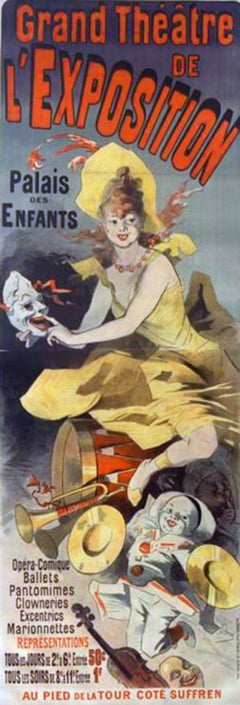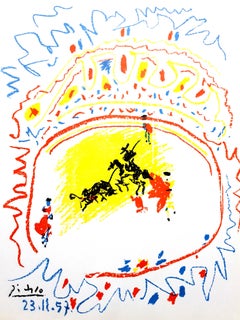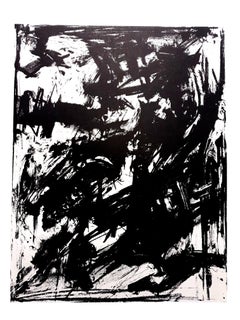(after) Jules Cheret Animal Prints
to
1
Overall Width
to
Overall Height
to
1
7
194
161
119
94
1
1
1
1
1
1
1
Artist: (after) Jules Cheret
Grand Theatre de l’Exposition, from Les Maîtres de l'Affiche
By (after) Jules Cheret
Located in New York, NY
This lithograph in colors with raised chop mark was printed by Imprimerie Chaix in Les Maîtres de l'Affiche, 1899, on fine woven, heavy stock paper. Measures 15 ¾ x 11 3/8 (40 x 29 c...
Category
19th Century Modern (after) Jules Cheret Animal Prints
Materials
Lithograph
Related Items
Pablo Picasso - La Petite Corrida - Original Lithograph
By Pablo Picasso
Located in Collonge Bellerive, Geneve, CH
Pablo Picasso - Original Lithograph
La Petite Corrida (The Small Bullfight)
1958
Edition of 2000, unsigned
Published in the journal XXe Siecle
Dimens...
Category
1950s Modern (after) Jules Cheret Animal Prints
Materials
Lithograph
$3,964
H 12.6 in W 9.85 in D 0.04 in
Emilio Vedova - Original Lithograph
By Emilio Vedova
Located in Collonge Bellerive, Geneve, CH
Emilio Vedova - Original Lithograph
Abstraction
1961
From the art revue XXe Siecle
Dimensions: 32 x 24
Edition: G. di San Lazzaro.
Unsigned and unumbered as issued
Category
1960s Modern (after) Jules Cheret Animal Prints
Materials
Lithograph
Pablo Picasso - Jeu de la Cape - Lithograph
By Pablo Picasso
Located in Collonge Bellerive, Geneve, CH
Lithograph by Picasso
Atelier Mourlot.
Paper: Vélin.
Dimensions : 9 5/8 x 12 7/16 inches
Reference: Bloch 1015
Picasso is not just a man and his work. Picasso is always a legend, ...
Category
1960s Modern (after) Jules Cheret Animal Prints
Materials
Lithograph
“Le Picador II” from the book Sabartés
By Pablo Picasso
Located in Collonge Bellerive, Geneve, CH
“Le Picador II” from the book Sabartés, “A los Toros avec Picasso“ 1961, from the edition of unknown size, printed by Mourlot Frères, Paris, published by Andre Sauret, Monte Carlo.
...
Category
1960s Modern (after) Jules Cheret Animal Prints
Materials
Lithograph
“Europa and the Bull”
By Alvar Sunol Munoz-Ramos
Located in San Francisco, CA
You have to hand it to the bull. Not just taking Europa with his unassailable power (he is Zeus in disguise, after all) he brings along a retinue for his seduction of the beautiful P...
Category
1980s Modern (after) Jules Cheret Animal Prints
Materials
Paper, Lithograph
Le Goût de Bonheur: one plate (Woman)
By (after) Pablo Picasso
Located in Collonge Bellerive, Geneve, CH
Artist: Pablo Picasso (after)
Medium: lithograph, Arches paper
Portfolio: Le Goût de Bonheur
Year: 1970
Edition: Total of 1998 copies (666 each in G...
Category
1960s Modern (after) Jules Cheret Animal Prints
Materials
Lithograph
Georges Braque - Birds - Original Lithograph
By Georges Braque
Located in Collonge Bellerive, Geneve, CH
Georges Braque - Birds - Original Lithograph
Published in the deluxe art review, XXe Siecle
1958
Dimensions: 32 x 24 cm
Publisher: G. di San Lazzaro.
Unsigned and unumbered as issued
Category
1950s Modern (after) Jules Cheret Animal Prints
Materials
Lithograph
Maurice Estève - Composition - Original Lithograph
By Maurice Estève
Located in Collonge Bellerive, Geneve, CH
Maurice Estève - Composition - Original Lithograph
Colorful Abstraction
1969
From the art review XXe Siecle
Dimensions: 32 x 24 inches
Edition: G. di Sa...
Category
1960s Modern (after) Jules Cheret Animal Prints
Materials
Lithograph
$1,183
H 12.6 in W 9.45 in D 0.04 in
Pablo Picasso - Les Banderillas - Original Lithograph
By Pablo Picasso
Located in Collonge Bellerive, Geneve, CH
Original Lithograph by Picasso
Atelier Mourlot.
Paper: Vélin.
Dimensions : 9 5/8 x 12 7/16 inches
Bloch 1017; Cramer 113; Mourlot 350
Category
1960s Modern (after) Jules Cheret Animal Prints
Materials
Lithograph
$1,597
H 10.24 in W 12.6 in D 0.04 in
Alberto Giacometti - Original Lithograph
By Alberto Giacometti
Located in Collonge Bellerive, Geneve, CH
Alberto Giacometti - Original Lithograph
1964
Dimensions: 38 x 28 cm
From the journal Derrière le Miroir No. 148, 1964
Edition: Foundation Maeght at Saint Paul
Alberto Giacometti...
Category
1960s Modern (after) Jules Cheret Animal Prints
Materials
Lithograph
$1,538
H 14.97 in W 11.03 in D 0.04 in
Le Goût de Bonheur: one plate - Colorful Portrait
By (after) Pablo Picasso
Located in Collonge Bellerive, Geneve, CH
Artist: Pablo Picasso (after)
Medium: lithograph, Arches paper
Portfolio: Le Goût de Bonheur
Year: 1970
Edition: Total of 1998 copies (666 each in German, French and English)
Sheet S...
Category
1970s Modern (after) Jules Cheret Animal Prints
Materials
Lithograph
$1,420
H 13 in W 10 in D 0.1 in
The Human Comedy - Lithograph
By (after) Pablo Picasso
Located in Collonge Bellerive, Geneve, CH
After Pablo Picasso
The Human Comedy - Lithograph after an original drawing, as published in the journal "Verve"
Printed signature and date
Dimensions...
Category
1950s Modern (after) Jules Cheret Animal Prints
Materials
Lithograph
(after) Jules Cheret animal prints for sale on 1stDibs.
Find a wide variety of authentic (after) Jules Cheret animal prints available for sale on 1stDibs. You can also browse by medium to find art by (after) Jules Cheret in lithograph and more. Much of the original work by this artist or collective was created during the 19th century and is mostly associated with the modern style. Not every interior allows for large (after) Jules Cheret animal prints, so small editions measuring 12 inches across are available. (after) Jules Cheret animal prints prices can differ depending upon medium, time period and other attributes. On 1stDibs, the price for these items starts at $695 and tops out at $695, while the average work can sell for $695.
Questions About (after) Jules Cheret Animal Prints
- 1stDibs ExpertApril 5, 2022Jules Cheret contributed to poster history by changing how the art world viewed posters. In 1884, he showed his works in the first-ever gallery exhibition of posters, helping to elevate the art form. Find a variety of Jules Cheret art on 1stDibs.


